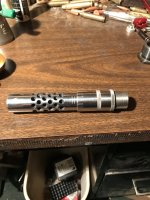All joking aside read the last line from Dr Geofftey Kolbe if you can.
Conclusions
It has been shown that the launch time of the bullet from the barrel, with reference to the transverse vibrations in the barrel, does vary with muzzle velocity, and this rate has been measured for Eley Tenex .22 rimfire ammunition in a 26 inch barrel. The proposition that positive compensation might be achieved by "tuning" a barrel, such that the muzzle angle is changing with time in a beneficial way at bullet launch, is thus a valid one.
In a test case, the vertical dispersion at a range of 50 metres was measured as a function of muzzle velocity for an "untuned" barrel. From this dispersion, and the known rate of change of launch time with muzzle velocity for a 26 inch barrel, a rate of change of angle at the muzzle for this barrel was calculated. Using an apparatus built to measure the rate of change of angle of a barrel, the rate of change of angle at the muzzle was measured and this agreed with that calculated from the group dispersion. This demonstrated that the apparatus was working as designed. It also showed that the vertical velocity of the muzzle is probably not significant in contributing to the vertical dispersion of the group in general, compared to the rate of change of muzzle angle, and was certainly not so in this case.
Finally, the barrel was "tuned" by attaching a weight to the front of the barrel, such that the rate of change of angle at the muzzle was now 6.0 MOA per millisecond at bullet launch, which is the rate of change required for complete positive compensation at 50 metres. The groups fired with the tuned barrel were small and round, showing no sign of vertical dispersion, so demonstrating that positive compensation had been achieved.
The measurement of barrel vibrations in the way demonstrated will be a very quick and positive method of tuning a rifle, requiring very few shots and very little time. Moreover, there is no ambiguity or uncertainty about the result. When the barrel is tuned for complete positive compensation, no further improvement is possible.


